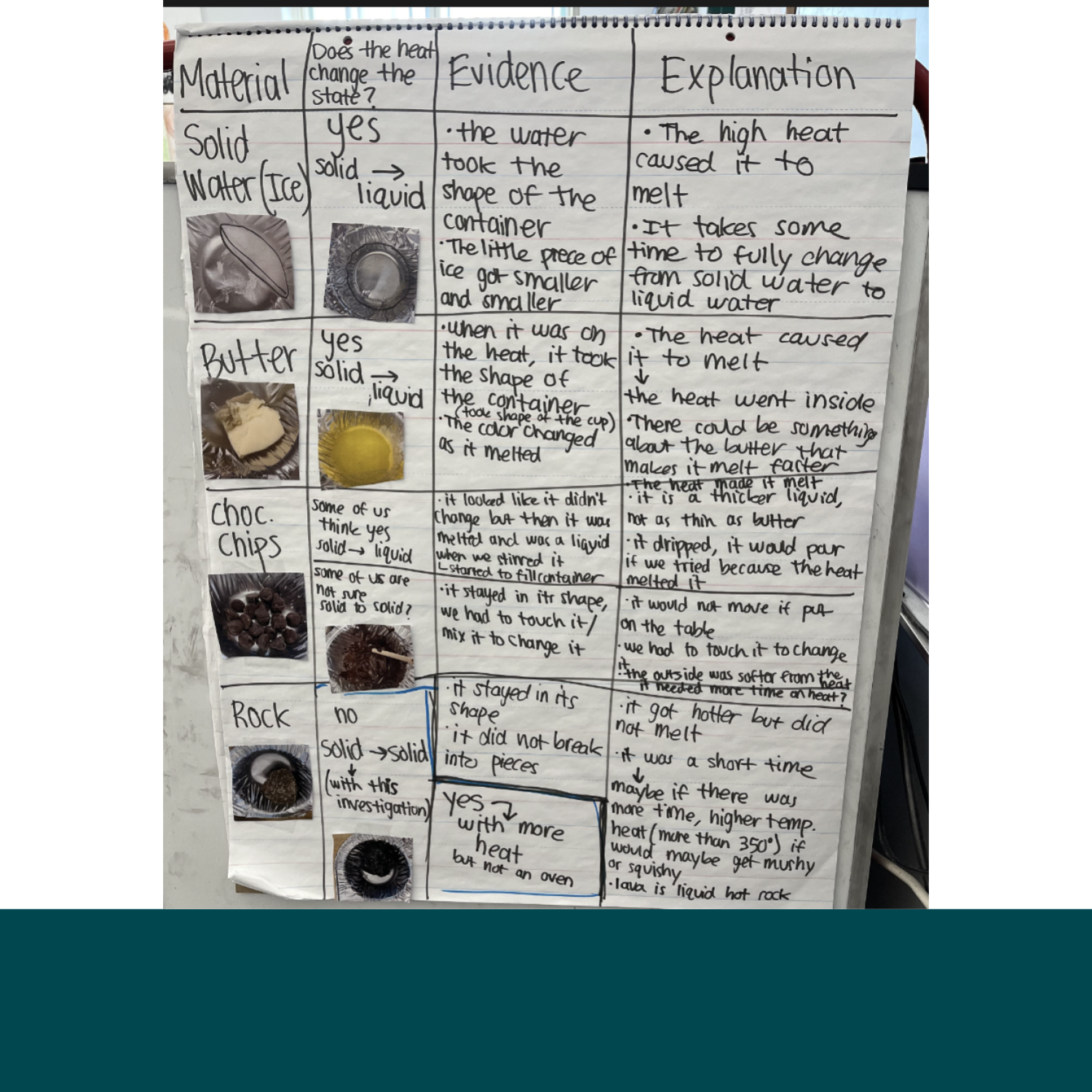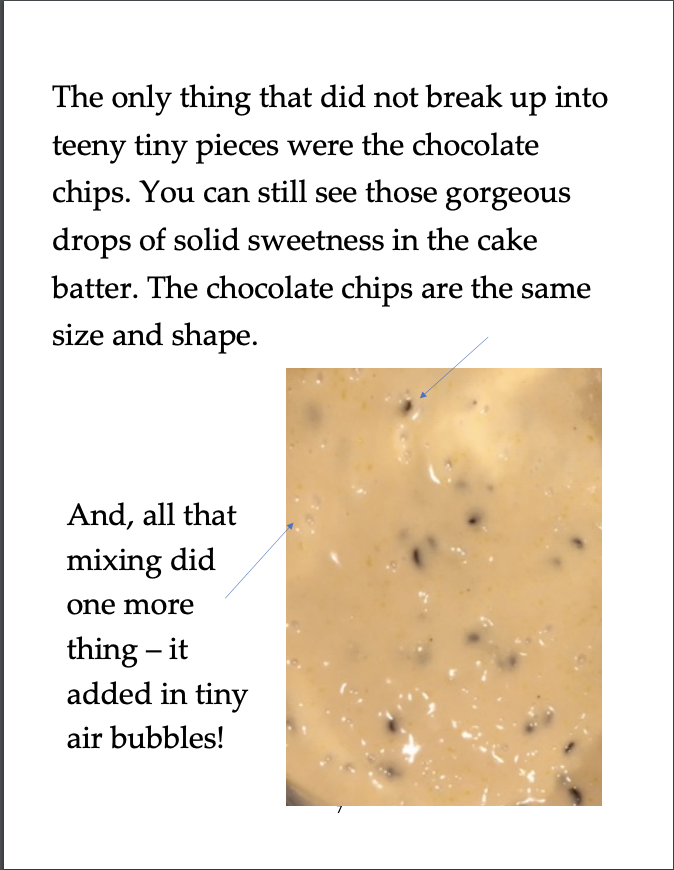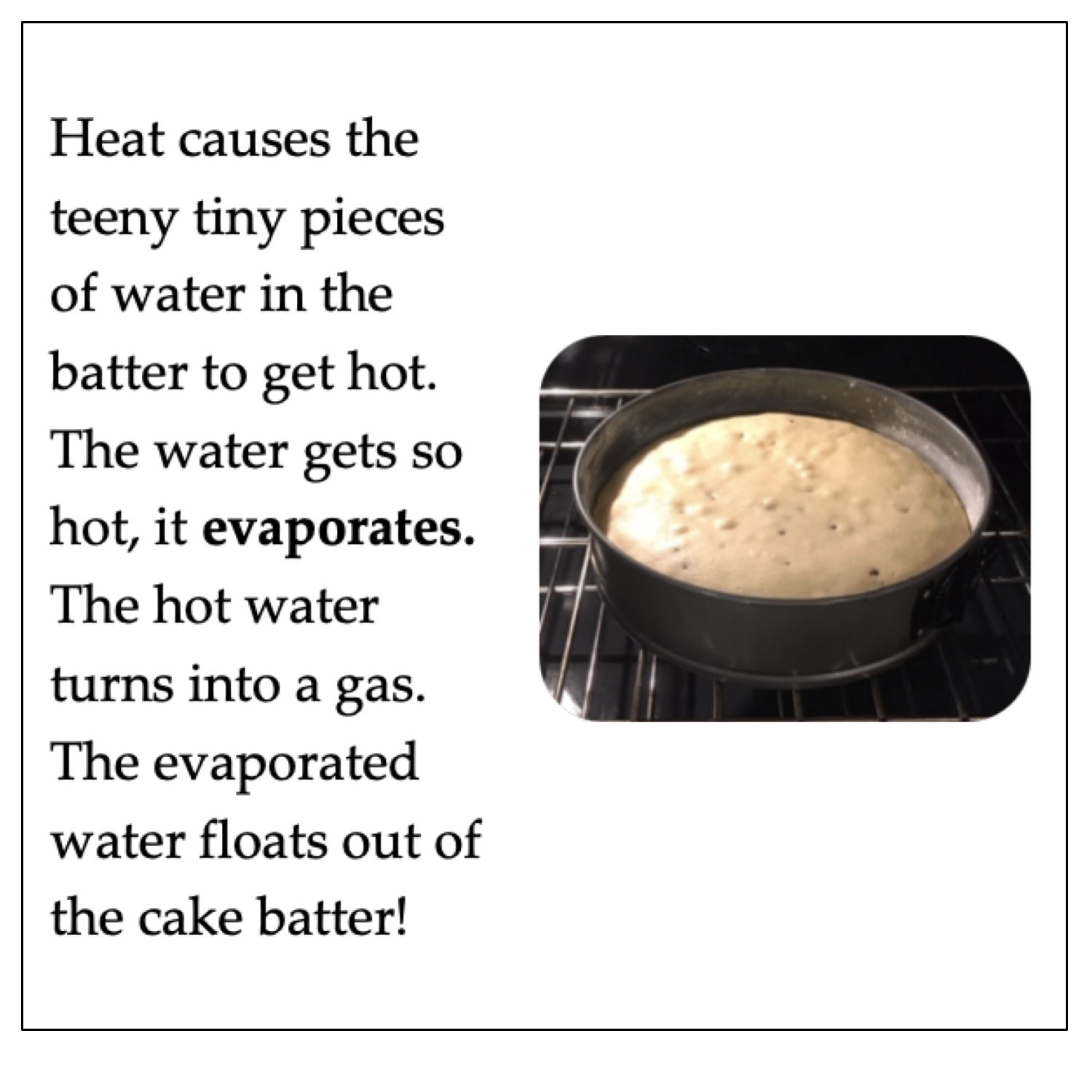“Those Air Bubbles Are Like Secret Steam Tunnels”: Using Resources to Support Explanation
Case at a Glance
Investigation: Heating and Cooling
Investigation Phase: Developing Explanations
Teaching Practices:
Connecting students’ thinking across representations
Expressing excitement for uncertainty
Orienting to students’ ideas and supporting students to respond to one another’s ideas
Using resources such as books to build on students’ sensemaking
About the Classroom: This is a second-grade classroom comprising both monolingual children whose families speak English at home and multilingual children whose families speak Spanish or Portuguese at home.
Context: This case takes place during the Heating and Cooling Investigation, after children have observed materials and made claims about how and why materials change when heat is applied. Lauren uses a read aloud to help students use their findings to explain why cake batter becomes (and stays) solid after being baked.
Introduction
This case takes place during the Heating and Cooling Investigation. Lauren uses the phenomenon of baking a cake to motivate an exploration of how materials such as butter, ice, chocolate chips, and eggs change when heat is applied and removed. Students’ investigations help them to make progress on learning objectives such as developing rich describing words for properties, using properties to differentiate liquids and solids, considering how adding and removing heat changes matter, and supporting a claim with evidence. Constructing a complete explanation of how ingredients turn into a cake based solely on the investigation results is not possible, nor is it Lauren’s main objective. Lauren uses a read aloud to help students connect their results and discussions to an explanation of why the cake becomes a solid.
In this case we see how using a resource like a read aloud can support children to make progress on their puzzles and questions as:
Children make sense of their investigation results
Children draw on ideas from a book to construct and refine explanations
Children see their ideas represented in the text and deepen explanations
Case Background
Children have already heated ice, butter, chocolate chips, a rock, and an egg (Image 1). They make claims about how materials change state when they are heated and what happens when heat is removed. They record these ideas on a chart (Image 2). At the end of the investigation, they agree that some materials change state when heat is added (ice, eggs), that different materials require different amounts of heat to change state, and that some changes are not reversible (the egg). However, they still have some questions: Are heated chocolate chips in the cake liquid or solid? Do some materials require more heating time to change state?
As they turn back to explaining how the cake batter changed into a solid, then stayed a crumbly cake, they apply their findings to explain the phenomenon. But some of their uncertainties continue to vex them, and new questions emerge.
Uncertainty in Action
Children make sense of their investigation results
After the investigation, Lauren and Eve facilitate a sensemaking conversation about how the children’s results could help them explain why the cake stays solid once it is cooked. Behind her, Lauren projects a slide showing the ingredients of the cake and the three stages of the cake-cooking process: the unbaked batter, the cooked cake, and a cross-section of the cooled cake. She asks, "How can we now use the information from our investigations to explain why did the cake go from that liquid to a solid? And when it sat out in the room, why did it stay a solid cake? Why didn't it just go back to that liquid batter as it cooled down?“
Bianca: I noticed that when the cake is in the oven, it goes up and up.
Paulina: I think that the cake goes up because of the water.
Lauren: You think the cake going up has something to do with the water? Tell me what you mean by that.
Paulina: The water getting hotter made the cake like that.
Lauren: Tell me why. Why do you think that?
Paulina: When the cake goes up, the water in the cake dries out.
Kenji: I think the reason why the cake has holes is because it’s where water tried to come out but it was trapped and it created these kinds of holes inside.
Lauren: Can you come point at the board to explain what you mean about the holes where the water got trapped? So you’re saying in that slice of the cake, that hole in there, you’re proposing that's where water was trying to come up out and then it got stuck, and when it got stuck, it did what?
Kenji: (Points at the holes in the baked cake slice; Image 3.) It made a hole.
Eve: I’m going to try to make a connection but maybe you or another person can help build it. Yesterday we learned that water, when heat is added, it can change from solid water to liquid water, and then liquid water when heat is added can turn to gas. What you’re talking about with the holes, does it connect either to solid water turning to liquid water or does it connect to liquid water turning to gas?
Kenji: I think it’s liquid water turning to gas trying to propel all the other things away and then it created the holes.
Yonas: I think the little holes that Kenji’s sharing with you, I think it might be like where air came from maybe.
Lauren: Tell me what you mean by where air came from?
Yonas: Like in there (points to picture of mixing batter) air made bubbles. And when you cook it and you slice it up, you can’t even see them in the whole cake (points to the cooked cake), but I see them. There are holes (points to holes in the slice of cake; Image 4), but I think the air was going through it and it made the holes.
Eve: So maybe it got one gas, air, in it when we were stirring, and it got another gas, water, by being heated?
Lauren tells the class that the next time they meet, she will share a read aloud that will give them more information about why the cake changed.
What we see…
-
Students are uncertain about the mechanisms by which the cake becomes and stays solid.
They wonder whether the evaporation of water in the batter causes the cake to rise and dry up and whether the holes are created by steam or air mixed into the batter or both.
They also wonder how the different factors (steam, water) can explain the batter turning into a solid.
-
Students use ideas from their personal experiences to think about how the ingredients they investigated make the cake solid.
Students point and gesture to the images to communicate their ideas about the holes in the cake and where they came from.
Students draw on connections to a previous book.
-
Lauren and Eve connect students' thinking to their investigations and to the phenomenon.
Lauren invites students’ ideas. She values their contributions and suggests their questions and puzzles are valuable tools for community knowledge development.
Lauren helps students orient and respond to each other’s ideas by inviting gesture and probing for clarification.
Children draw on ideas from the book to construct and refine explanations
Lauren introduces the book, "A Delicious Experiment" as a tool for students to use to make progress on their ideas and puzzles. As she reads from the book, she supports students to share their ideas and to connect their findings to the new information in the text.
Lauren is the front of the class and students are sitting on the rug. A page from “A Delicious Experiment” is projected (Image 5).
Lauren: The only thing that did not break into teeny, tiny pieces were the chocolate chips. You can still see those gorgeous drops of solid sweetness in the cake batter. The chocolate chips are the same size and shape and all that mixing did one more thing, it added in tiny air bubbles.
Lauren: Grayson?
Grayson: So, from the book we can also learn that like um, the chocolate chips didn’t melt and take the form of, of um, the bowl, and it stayed as a solid.
Lauren: That's right. So, it didn't melt, and it didn't take the form of the bowl. It stayed as a solid. And I heard Yonas also say, just like with ours, how there's those tiny—and this is pointing out what we suspected—that there’s those tiny air bubbles (gesturing tiny bubbles with hands) that get in there. Yes, Edward?
Edward: You know how you put the chocolate chips in your, in the cake? Um, it didn't melted because the butter and the egg and the flour didn't. It wasn't, like, really hot. It was like a little bit tiny cold. That's why the, the, um, the the chocolate chip didn't melted.
Maya: How do they stay a solid? How would it still? Wait…
Lauren: Go ahead, Maya. Go ahead.
Maya: I think how it stays a solid is all that liquidness, you know how like when you bit (puts hand up to mouth) the chocolate chip? When the cake was a solid, and you ate it? The chocolate chips were still intact. And like there was no liquid. They were a solid. And I think so because that liquid is protecting the chocolate chips. Also, because it’s in something. But the only part that you know is gonna change is the cake batter and melt the chocolate chips.
Lauren: So, you think something about that cake batter liquid is protecting the chocolate chips?
Maya: Like how our skin protects. It’s the same thing.
5. Page from the read-aloud.
-
Children grapple with uncertainty about how to explain how the chocolate chips can keep their shape when heat is applied, an uncertainty they wrestled with in the investigation too. They make new connections, including to the cake batter’s role helping the chips keep their shape.
-
Students use information from the book to build off their prior learning about how solids that melt into a liquid take the shape of their container. If the chocolate chips are the same size and shape, they must not have melted. But how could that be?
-
Lauren continues to use the text to validate students’ thinking, revoice student ideas, and connect ideas to one another and the larger phenomenon.
She asks students to come and gesture at the board and checks multiple times that she is accurately representing their ideas when she revoices.
Lauren gives students space to make sense of new information and continues to welcome new puzzles.
Children see their ideas represented and deepen explanations
Lauren: Okay, so I’m going to keep going, friends, because these are also some ideas that we have been talking through. Heat causes the teeny tiny pieces of water in the batter to get hot. The water gets so hot, it evaporates. The hot water turns into a gas. The evaporated water floats out of the cake batter.
Yonas: Like Kenji said!
Kenji: I think the reason why it has all those bumps on the top is because the, the air tried to escape, and it created all the little bumps.
Lauren: So friends, I want to also highlight something for all of you. A lot of you yesterday had started to bring up that idea of the water gas trying to get out, or how– Paulina, I remember you saying it might start to dry out and leave. That is something that is really difficult to explain, and this book is confirming that that is part of what happens to turn it into a cake.
Lauren: How cool is that?
Multiple students: Cool! (raising their hands)
Devon: But also, that makes the air bubbles. And there's no–I think there would be no room for the steam to come out of the cake.
Lauren: So those air bubbles–
Devon: Those air bubbles are like secret tunnels.
Edward: Remember like a long time ago I said when the cake was um already been made and I said, like how the there's bumps and holes in there. I think that's why there's bump on the cake when you're making it. I think it made the bump because like, you know how you cook something, there's things popping.
6. Page from the read aloud.
What we see …
-
Students have identified steam and air as possible mechanisms by which holes are incorporated into the cake but continue to be uncertain about whether they have a satisfying explanation.
Now, Devon adds a new idea about the holes being air bubbles that allow the steam to escape.
Edward and Kenji connect ideas about the steam coming out of the cake to the bumps on top of the cake; maybe steam escaping is a mechanism by which the bumps on the cake are formed.
-
Students use the new ideas in the book to build off of ideas that have repeatedly come up during their discussions. The book confirms that hot water floats out of the cake. They had previously conjectured that the holes in the cake are made by water trying to escape. Now they think that maybe the escaping air is also responsible for the bumps on the cake.
-
Lauren expresses excitement that students’ ideas are represented in the book and continues to make space for student thinking about the causes of different features of the cake.
Reflection
This case shows how teachers can leverage read alouds to support students in developing explanations that build from their investigations. Before the read aloud, students were uncertain, but had hunches about the role of steam in irreversibly turning the cake into a solid. During the read aloud, children were able to see their ideas in the text, make connections to the explanations in the book, and continue to think about how ingredients were changing in the cake (for example about how chocolate chips might hold their shape in the cake even as it bakes). They continue to express excitement and actively build explanations using the book as a resource.
We encourage you to reflect on your teaching practices in light of your learning from this case:
How can I use resources to help students make sense of their learning in a way that builds from, rather than cuts off or replaces, their sensemaking?
How can I anticipate where students may struggle to make connections between the investigation and explanation they are seeking to develop? What strategies can I use to help them make connections without reducing sensemaking?







